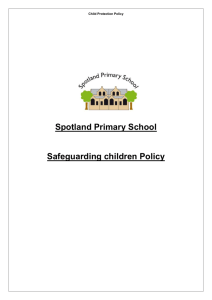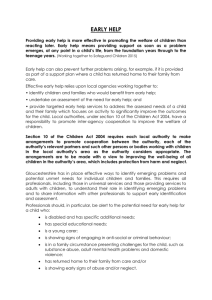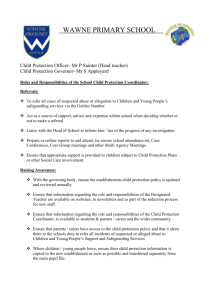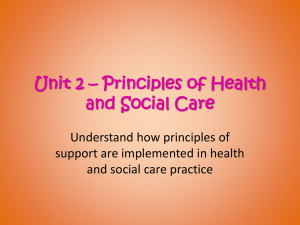- Contact a Family
advertisement
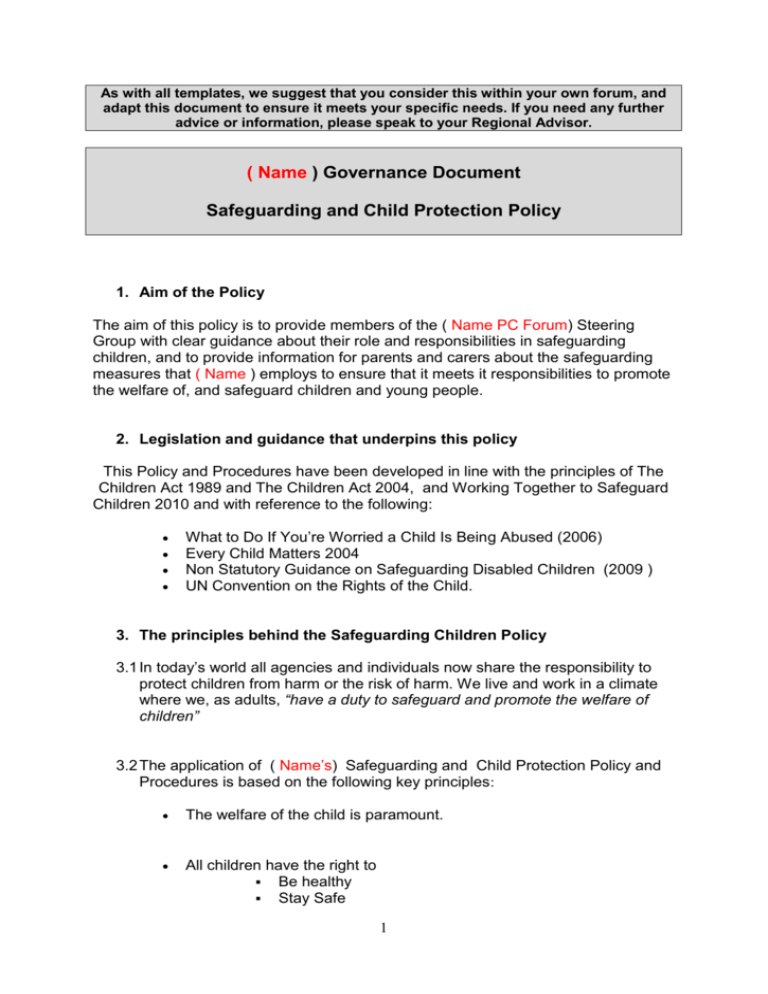
As with all templates, we suggest that you consider this within your own forum, and adapt this document to ensure it meets your specific needs. If you need any further advice or information, please speak to your Regional Advisor. ( Name ) Governance Document Safeguarding and Child Protection Policy 1. Aim of the Policy The aim of this policy is to provide members of the ( Name PC Forum) Steering Group with clear guidance about their role and responsibilities in safeguarding children, and to provide information for parents and carers about the safeguarding measures that ( Name ) employs to ensure that it meets it responsibilities to promote the welfare of, and safeguard children and young people. 2. Legislation and guidance that underpins this policy This Policy and Procedures have been developed in line with the principles of The Children Act 1989 and The Children Act 2004, and Working Together to Safeguard Children 2010 and with reference to the following: What to Do If You’re Worried a Child Is Being Abused (2006) Every Child Matters 2004 Non Statutory Guidance on Safeguarding Disabled Children (2009 ) UN Convention on the Rights of the Child. 3. The principles behind the Safeguarding Children Policy 3.1 In today’s world all agencies and individuals now share the responsibility to protect children from harm or the risk of harm. We live and work in a climate where we, as adults, “have a duty to safeguard and promote the welfare of children” 3.2 The application of ( Name’s) Safeguarding and Child Protection Policy and Procedures is based on the following key principles: The welfare of the child is paramount. All children have the right to Be healthy Stay Safe 1 Enjoy and Achieve Make a positive contribution Achieve economic wellbeing All children, whatever their age, culture, disability, gender, language, racial origin, religious belief and/or sexual identity have the right to protection from abuse. 4.3 Whilst it is not the responsibility of this organization to determine whether or not abuse has taken place (this is undertaken in liaison with external child protection professionals), it is everyone’s responsibility to report any concerns in relation to children, or vulnerable adults to the relevant authority. 4.4 The ( Name ) Steering Group does not have direct contact with children and young people, however by the nature of the organisation we work directly with parent carers of disabled children and young people. Therefore it is essential that we have robust policies and procedures.( or change wording as appropriate) 4.5 All Steering Group members are expected to be familiar with, and comply with this policy, and it’s procedures. 4. Policy Parent carers of children who attend or are members of ( name ) need to be aware that any concerns that a child or vulnerable adult has, or may be experiencing harm, which comes to the attention of Steering Group members may be referred to the local statutory agency. That Steering Group members, and any staff employed by the ( name ) will be recruited using safe recruitment practices (including the taking of references and a CRB check) to ensure they are suitable individuals to take on a role which puts them into contact with large numbers of parent carers. Steering Group Members and staff will be provided with training and induction to assist them to fulfil their duties. 5. Procedures: 6.1 Whilst recognising that the ( Name) Steering Group will have little direct contact with children and young people, it’s work with parent carers means that they may indirectly have contact with children and young people, and certainly have contact with parent carers who often live in particularly challenging situations. 6.2 Therefore these procedures are designed to support the recognition of abuse of children, and provide clear guidance about what processes and actions 2 should be taken if this is identified to ensure that children are safeguarded and protected. 6. Definitions and signs of abuse 7.1 There are four recognised types of abuse and it is important that all staff and volunteers know what they are and how to recognise them. Your policy should include this information so that it works as a point of reference for all staff. The following definitions are based on those from Working Together to Safeguard Children (DCSF 2010) 7.2 Physical Abuse Physical abuse may involve hitting, shaking, throwing, poisoning, burning or scalding, drowning, suffocating or otherwise causing physical harm to a child. Physical harm may also be caused when a parent or carer feigns the symptoms of, or deliberately causes ill health to, a child whom they are looking after. A person might do this because they enjoy or need the attention they get through having a sick child. Physical abuse, as well as being a result of an act of commission can also be caused through omission or the failure to act to protect. 7.3 Emotional Abuse Emotional abuse is the persistent emotional maltreatment of a child such as to cause severe and persistent adverse effects on the child’s emotional development. It may involve making conveying to children that they are worthless or unloved, inadequate, or valued only insofar as they meet the needs of another person. It may feature age or developmentally inappropriate expectations being imposed on children. These may include interactions that are beyond the child’s developmental capability, as well as overprotection and limitation of exploration and learning, or preventing the child participating in normal social interaction. It may involve seeing or hearing the ill-treatment of another. It may involve serious bullying, causing children frequently to feel frightened or in danger, or the exploitation or corruption of children. Some level of emotional abuse is involved in all types of maltreatment of a child, though it may occur alone. 7.4 Sexual Abuse Sexual abuse involves forcing or enticing a child or young person to take part in sexual activities, including prostitution, whether or not the child is aware of what is happening. The activities may involve physical contact, including penetrative (e.g. rape, buggery or oral sex) or non-penetrative acts. They may include non-contact activities, such as involving children in looking at, or in the production of, sexual on-line images, watching sexual activities, or encouraging children to behave in sexually inappropriate ways. Boys and 3 girls can be sexually abused by males and/or females, by adults and by other young people. This includes people from all different walks of life. 7.5 Neglect Neglect is the persistent failure to meet a child's basic physical and/or psychological needs, likely to result in the serious impairment of the child's health or development. Neglect may occur during pregnancy as a result of maternal substance abuse. Once a child is born it may involve a parent or carer failing to provide adequate food, shelter and clothing, failing to protect a child from physical harm or danger, failure to ensure adequate supervision (including the use of inadequate care givers) or the failure to ensure access to appropriate medical care or treatment. It may also include neglect of, or unresponsiveness to, a child's basic emotional needs. 7. Safeguarding disabled children and young people There is clear evidence that disabled children and young people have an increased vulnerability to being abused, and that the presence of multiple impairments further increases their vulnerability. There are many reasons for this, and it is important that all those who work with disabled children and young people have some understanding of these reasons, and ensure that they offer appropriate support to any child or young person who discloses abuse. 8. Guidance on how to respond to a child / young person / vulnerable adult disclosing abuse 9.1 9.2 DO: Do treat any allegations extremely seriously and act at all times towards the child as if you believe what they are saying. Do tell the child they are right to tell you. Do reassure them that they are not to blame. Do be honest about your own position, who you have to tell and why. Do tell the child what you are doing and when, and keep them up to date with what is happening. Do take further action – you may be the only person in a position to prevent future abuse – tell your nominated person immediately. Do write down everything said and what was done. DON’T: Don’t make promises you can’t keep. 4 Don’t interrogate the child – it is not your job to carry out an investigation – this will be up to the police and Children’s social care, who have experience in this. Don’t cast doubt on what the child has told you, don’t interrupt or change the subject. Don’t say anything that makes the child feel responsible for the abuse. Don’t do nothing – make sure you tell your nominated Safeguarding Children person immediately – they will know how to follow this up and where to go for further advise. 10. Should we tell parent / carers if we are going to make a referral? 10.1 It is good practice to be as open and honest as possible with parent carers about any concerns and you if you need to make a referral to social care, you should normally discuss this with the parent carer before you do. However, inability to inform parent carers should not prevent a referral being made. It would then be a joint decision with Children’s Social Care about how and when the parents should be approached and by whom. 10.2 However you should NOT discuss your concerns with parent carer in the following circumstances 11. 11.1 Where sexual abuse or sexual exploitation is suspected Where organised or multiple abuse is suspected. Where Fabricated or Induced Illness (previously known as Munchausen Syndrome by Proxy) is suspected Where Female Genital Mutilation is the concern In cases of suspected Forced Marriage Where contacting or discussing the referral would place a child, yourself, or others at immediate risk. Guidance on how to respond to a parent carer disclosing abuse DO: If you enter into a discussion with a parent carer who you believe may begin to disclose information which leads you to believe that a child has suffered, or may suffer harm, make sure they know as soon as possible that you will not be able to keep this information to yourself. Do treat any allegations extremely seriously and act at all times towards the parent carer as if you believe what they are saying. Do tell the parent carer they are right to tell you.. Do be honest about who you have to tell and why. 5 11.2 If a referral needs to be made to safeguarding, encourage the parent carer to make the referral themselves. Support them if necessary – however be clear that if they won’t do this you will have to do this. Do make sure you are clear (if possible) where the child / young person / vulnerable adult is at the current time, and consider their immediate safety. If you have to make the referral, do tell the parent carer what you are doing and when, and keep them up to date with what is happening. Do write down everything said and what was done. DON’T: Don’t make promises you can’t keep – e.g. tell people they can tell you things in confidence. Don’t interrogate the parent carer – it is not your job to carry out an investigation – this will be up to the police and Children’s social care, who have experience in this. Don’t do nothing – make sure you tell your nominated Safeguarding Children person immediately – they will know how to follow this up and where to go for further advise. 12. Reporting Procedures – DO NOT DELAY 12.1 Emergency Situations If emergency medical attention is required this can be secured by calling an ambulance (dial 999) or taking a child to the nearest Accident and Emergency Department. 12.2 If a child is in immediate danger the police should be contacted (dial 999) as they alone have the power to remove a child immediately if protection is necessary, via their powers to use Police Protection 12.3 Other situations It is vitally important that any disclosure made in confidence is recorded factually as soon as possible; this is whether or not the matter is taken to another authority. 12.4 An accurate account should be made of: Date and time of what has occurred and the time the disclosure was made Names of people who were involved What was said or done by whom Any action taken by the group to gather information and refer on Any further action, e.g. suspension of a worker or volunteer 6 Where relevant, reasons why there is no referral to a statutory agency Names of person reporting and to whom reported 12.5 The designated member of the ( Name ) responsible for Safeguarding Children should then use the appropriate reporting systems for the situation. This may be reporting the matter to Local Authorities Children’s Social Care (previously known as social services) or the police. This is why recording all information impartially and accurately is vital as this could be used for evidence for later use. 12.6 The Local Safeguarding Children’s Board will be able to provide you with Inter Agency referral forms to report a concern, or you may wish to devise your own form. Completed forms and any written information regarding Safeguarding Children issues concerning individual’s needs to be kept in a safe locked place to ensure confidentiality. 13. Recruitment selection and Vetting Process 13.1 Any employees will be subject to a rigorous recruitment process, which would include a vetting process with a CRB check, and references sought as well as a formal interview process. 13.2 Steering Group members will also be vetted to ensure that they are suitable individuals to take on a role which places them in contact with a large number of parent carers. This will include the taking of references, and a CRB check. 13.3 Steering Group Members and staff will be provided with training and induction to assist them to fulfil their duties. 14. Allegations against Adults who work with Children 14.1 If you have information which suggest an adult who works with children or young people (in a paid or unpaid capacity) has Behaved in a way that has harmed or may have harmed a child Possibly committed a criminal offence against, or related to a child Behaved towards a child/ren in a way that indicated s/he is unsuitable to work with children You should speak immediately with the nominated safeguarding advisor. The safeguarding officer will consult with / make a referral to the LADO for the relevant area. (Local Authority Delegated Officer) 15. Code of Conduct 7 15.1 ( Name ) has a Code of Conduct which all Steering Group members are expected to comply with. 15.2 The Code of Conduct has a clear section in relation to action taken should a safeguarding issue be raised in relation to a member of the Steering Group. 15.3 Steering Group members must inform the Chair about any personal difficulties that might affect your ability to exercise your responsibilities appropriately or risk bringing the name of ( Name) into disrepute. 15.4 The following are examples of types of circumstances Any allegation that an individual may have committed, or is being investigated in relation to having committed a crime Any child protection or safeguarding concern relating to children and / or vulnerable adults. Any significant challenge between individuals and Government agencies (e.g. where individuals may end up in a litigious relationship with a central or local Government Department) Other similar circumstances 15.4 In these situations, it will be standard practice to ask the Steering Group member to temporarily stand down until the issues are resolved. This is a neutral and non judgemental position, designed to protect the organisation and the individual, and to ensure the individual involved is able to focus all of their attention on the issue at hand. It is felt necessary however to insist on this protocol to safeguard both ( Name) and the individual involved. 16. Nominated safeguarding advisor ( to be included as required) 16.1 The nominated Safeguarding Advisor for ( Name) Steering Group is ( Name). 16.2 The role of the nominated officer is to: 17. To provide a single point of contact between ( Name) and the statutory child protection agencies- children’s social care and the police. To offer consultation and advice about safeguarding and child protection concerns pertaining to the activity of ( Name) Monitoring and review strategy This policy and procedure document will be reviewed on an annual basis. 8 Date policy completed Date policy should be formally reviewed. 9 June 2011 June 2012


